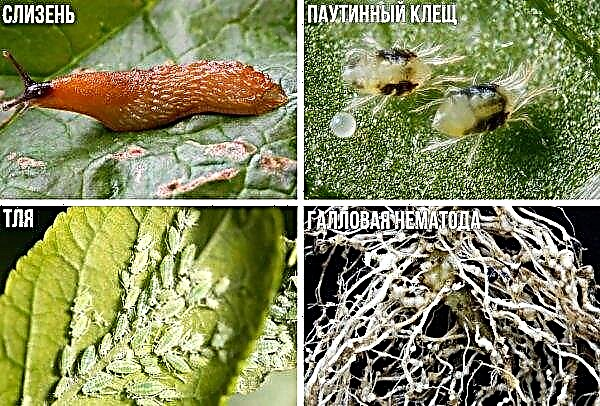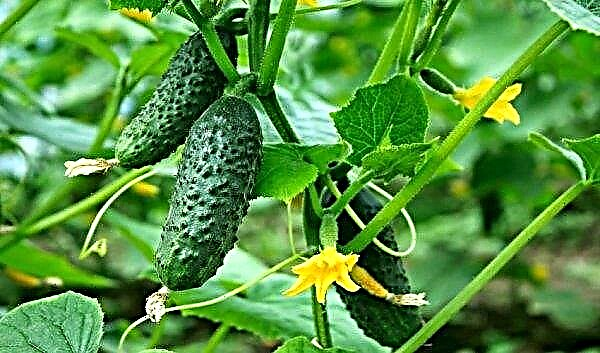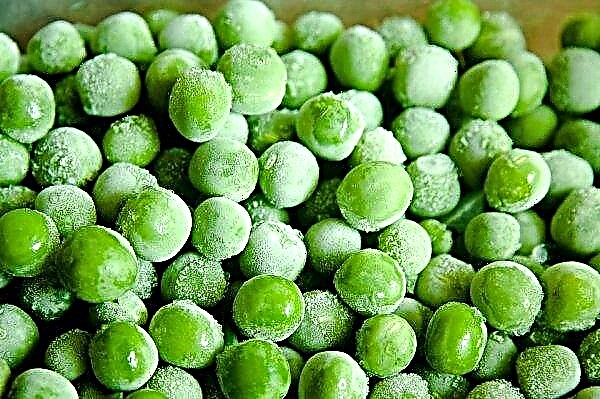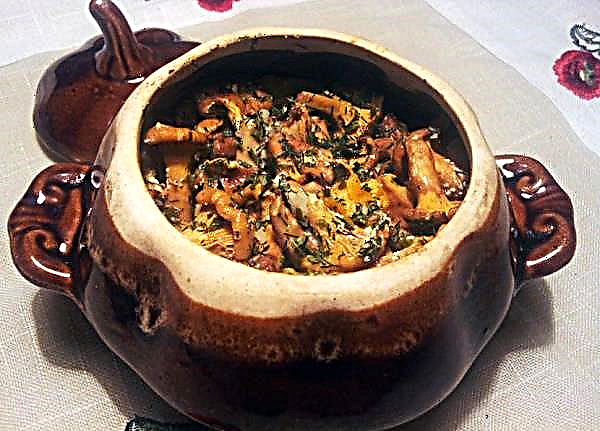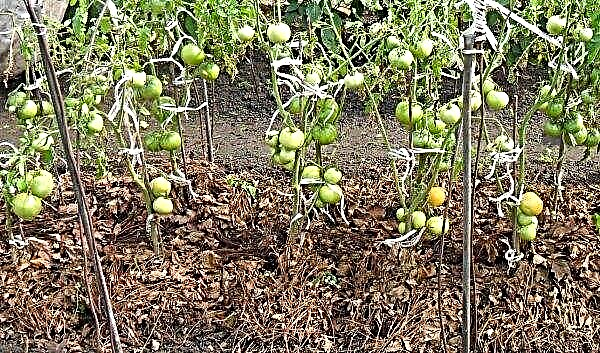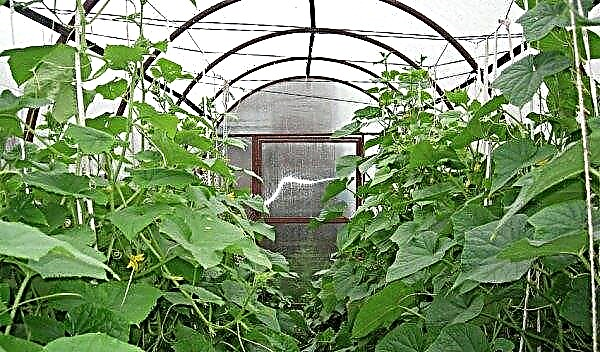Growing watermelons in Siberia is a difficult task, but quite real. In order for this agricultural event to succeed, it is necessary to choose the right variety of culture, and to follow certain rules when caring for it. What kind? Let's figure it out.
The best varieties of watermelons for growing in Siberia
For planting watermelons in cold regions, in particular Siberia, it is recommended to give preference to varieties that have a short ripening period and are able to easily survive cooling and temperature jumps.
Did you know? In the world there are about 1200 varieties of watermelons. However, all of them can be divided into four categories: with grains, without grains, small and yellow.
Experienced gardeners are advised to opt for these varieties:
- Astrakhan. Suitable for cultivation in harsh climates. You can grow an Astrakhan watermelon in just 70-85 days, and you get quite large berries weighing 5-6 kg, characterized by sweet, juicy pulp and a long shelf life at home.

- Light The described type of watermelons is characterized by early maturity, in which the fruits ripen 70-80 days after planting. The berries are very sweet, with dense, slightly granular flesh. The weight of watermelons rarely exceeds 2 kg. The light is characterized by excellent frost resistance, low maintenance, good keeping quality.

- Siberian. A type of plant that has been specially bred by breeders for cultivation in the regions of Siberia. The variety is not afraid of frost, temperature extremes and the negative impact of atmospheric phenomena. The berry, capable of reaching a weight of up to 5 kg, has a juicy, sweet pulp and a pleasant aroma. The vegetative period of fruit ripening is 75-80 days.

- Producer. Variety of watermelon Producer, although not suitable for cultivation in the open field, however, in greenhouse conditions is able to please a high yield. The vegetation period of the plant varies from 85 to 90 days. The berries are large, juicy, very sweet, have a stunning, pronounced aroma. The variety is resistant to disease, but very capricious in care.
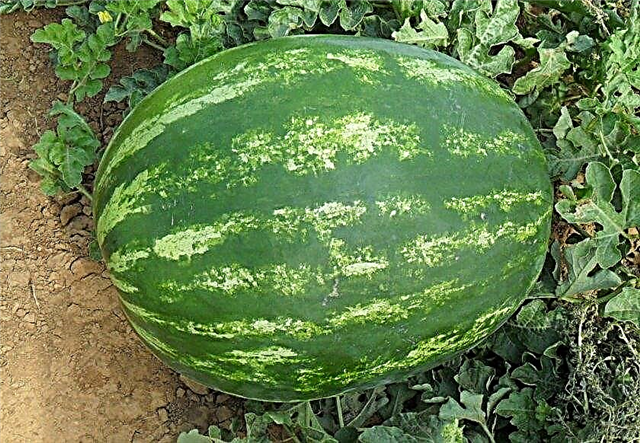
How to grow watermelons in Siberia
Even in regions with a cool climate, experienced gardeners are able to grow melons with excellent taste and aesthetic qualities. However, the cultivation of watermelons in these regions has a number of features.
Terms of planting seeds for seedlings
Watermelon seedlings should not be at home for more than 30-35 days. That is why it should be cultivated a month before the full warm summer begins in the Siberian regions, that is, in the last weeks of April - the first week of May.
Important! Sowing seeds directly into the ground in a short Siberian summer is useless, since there will be no crop. To obtain tasty, ripened fruits, you need to grow strong, healthy seedlings.
Seedling preparation
In order for the seedlings to take root in a cool climate, the seeds should be preliminarily prepared:
- the seeds are soaked in a weak solution of potassium permanganate for about 30 minutes;
- the material is dried and treated with any preparation to activate growth.

Further, it is recommended to harden the seeds:
- for 7 days in the afternoon, the seed is placed in the refrigerator;
- at night, the grains are left in the room.
Such events will strengthen the plant's immunity and increase the chances of its rapid maturation.
Planting and Seedling Care
Before planting seeds, prepare the soil mixture. For growing watermelons, soil, which consists of: humus and small expanded clay, mixed in a ratio of 3: 1, is perfect. Next, the process of sowing seed material is carried out according to the algorithm:
- soil mixture is poured into previously prepared containers, not adding about 5 cm to the top;
- moisten the soil with warm, settled water;
- 2 grains are placed in each container, sprinkled with soil, a layer of 3 cm;
- the surface of the soil is mulched with straw or sawdust.
Important! Watermelons are bad for transplantation and react negatively to damage to the root system. Therefore, experts advise planting seeds in peat cups or in disposable plastic glasses, which can be easily cut without damaging the roots.
Next, it is necessary to place the containers with seed material in a warm room, with stable temperature indicators + 27 ... + 30 ° C and good lighting for up to 12 hours. Window sills on the south side of the apartment will be an ideal place. With insufficient light, you need to organize additional illumination using phytolamps.
When caring for seedlings, waterlogging of the soil should not be allowed, since the roots will begin to rot. It is necessary to organize moderate watering, the need for which will be determined by drying of the top soil layer. Every 14 days, seedlings should be fed using any complex means. It is better to combine fertilizer application with watering: dissolve the drug in water and apply under seedlings.
A week before transplanting seedlings into the ground, it is necessary to prick it:
- glasses with sprouts are taken out into the open air, first for 1-2 hours, then daily periods of stay up to a whole day;
- the day before planting, seedlings are left on the street for a whole day.
Transplanting
Growing watermelons in Siberia can be carried out by two methods: in open ground and in a greenhouse. Let's look at a description of each of them.
Important! If you do not stop watering the plant two weeks before harvesting, then the fruits will begin to crack.
In open ground
The process of planting seedlings in open ground is not particularly difficult. Usually this event is held in late May - early June, when the positive night and day temperatures are fully stabilized.
Landing in open soil consists of several stages:
- Site selection. For planting seedlings choose a well-lit, sunny area, where there are no drafts, sharp gusts of wind. Ideal precursors for watermelon are potatoes, onions, cabbage. The plant prefers loose, light, nutritious soils with a subsurface groundwater of at least 2.5 m. It is recommended that the soil be loosened superficially and 4 kg of rotted manure are applied to each m² of soil. You can also add minerals to enrich the earth: 20 g of potassium salt, 40 g of superphosphate and 30 g of ammonium sulfate per 1 m².
- Planting process. To place the seedlings, they make rather large recesses with a width of 60-80 cm, while the distance between the bushes should be at least 1-1.5 m. The seedlings are immersed in the ground to the level of the lower cotyledon leaves, sprinkled with soil, and moisturized well. The surface of the soil around the plant is sprinkled with sand.

To the greenhouse
The term for planting seedlings in a greenhouse will depend on what temperature indicators it has. A favorable temperature for watermelons is considered to be + 25 ... + 30 ° C in the daytime and not lower than + 15 ° C in the night. In each greenhouse, such conditions develop at different times. As a rule, Siberian summer residents use polycarbonate greenhouses, in which planting of sprouts can be carried out after May 20. Planting events in glass and film greenhouses are carried out in the same period as in open ground.
Did you know? The word "watermelon" is translated from the Turkic language as "donkey cucumber." Indeed, this fruit is considered one of the most favorite donkey treats.
Soil preparation and the method of planting seedlings in the greenhouse is carried out by a similar method that in open ground, however, the planting scheme is more compact - 70 × 70 cm. If sprouts are planted in a greenhouse at a time when there is a risk of recurring night frosts, then experienced gardeners recommend providing seedlings additional thermal protection. For this, water is poured into plastic bottles and the containers are placed on a melon. In the daytime, the water in the bottle will heat up, and at night it will give off heat to the plants. If early ripe cultivars are recommended for cultivation in open ground, then in greenhouse conditions varieties with an average growing season can be grown.
For this, water is poured into plastic bottles and the containers are placed on a melon. In the daytime, the water in the bottle will heat up, and at night it will give off heat to the plants. If early ripe cultivars are recommended for cultivation in open ground, then in greenhouse conditions varieties with an average growing season can be grown.
Care Features
Since the melon crop described is characterized by early ripening, it will not take much time to grow it. Meanwhile, performing traditional plant care techniques is essential.
Watering
Watermelons prefer plentiful and frequent hydration. In dry weather, irrigation is recommended every three days. If rainy weather prevails, then it is enough to moisten the culture as the top layer of the soil dries up. It is very important to water the entire garden, as the melon has a very large root system. In greenhouse conditions, watermelons are moistened as necessary, 1-2 times a week. During the formation of fruits, irrigation is stopped. Soil hydration is discarded completely two weeks before harvest.
It is very important to water the entire garden, as the melon has a very large root system. In greenhouse conditions, watermelons are moistened as necessary, 1-2 times a week. During the formation of fruits, irrigation is stopped. Soil hydration is discarded completely two weeks before harvest.
Fertilizers and fertilizing
14 days after transplanting the seedlings, the culture is fed using organic means, for example, chicken droppings. To do this, prepare a special solution of 10 l of water, 20 g of litter, 15 g of calcium chloride and 30 g of superphosphate. Instead of chicken droppings, it is allowed to use ammonium nitrate - 20 g of the product per bucket of water.
It is especially important to organize plant nutrition during the budding period, since the plant urgently needs the nutritional components necessary for the full growth and development of the fruit. During this period, you need to make mineral preparations, for example, a mixture of 4 g of nitrate, 4 g of potassium chloride and 6 g of superphosphate. The mixture is scattered around the bushes and moistened with water from above.
Pest and Disease Control
Unfavorable weather conditions and illiterate care can cause the development of watermelon diseases and pests. Most often, the culture is affected by the melon aphid, the negative effect of which is manifested in the yellowing and twisting of the foliage, and, as a result of the complete death of the plant. Fighting the parasite helps processing bushes with a mixture of tobacco dust and ash, mixed in 1: 1 proportions.
This composition is sprinkled with the culture and 30 minutes after processing, the earth around the stem is loosened. In case of massive pest damage, modern broad-spectrum insecticides are used. In cold weather and high humidity, watermelons can be affected by fungal or bacterial ailments:
When the melon is affected, the diseased areas of the plant are removed, and the bush is treated with fungicidal preparations: Fundazole, Bordeaux solution, Oxychoma.Prevention of various ailments are:
- timely weeding and loosening of soil;
- crop rotation compliance;
- competent watering;
- periodic tillage around bushes with wood ash.
Features of harvesting and storage of crops
As a rule, varieties of watermelons are cultivated in Siberia with early vegetation periods, the harvest of which is carried out 80-90 days after transplanting. It is possible to determine the ripeness of a berry by tapping on its surface: ripe fruits will have a dull sound, ripening ones will have a loud sound.
In addition, ripe berries have a dry stalk, shriveled tendrils and petals, a dense bark that is difficult to pierce with a fingernail. The surface acquires brilliance and smoothness, a characteristic pattern is clearly manifested on it. If watermelons are planned to be stored or transported, then they are harvested a little immature.
For storage of watermelons, choose a dry, dark, cool, well-ventilated place, with temperature indicators of + 5 ... + 8 ° C and a humidity level of 60-80%. At lower or higher temperatures, the fruits spoil very quickly. Berries are stored in crates filled with straw or dry sand. For long-term storage, they are completely intact, without signs of damage and rot, fruits weighing 4-6 kg. When growing gourds in the harsh Siberian climate, one should not hope for huge yields. To enjoy delicious, aromatic and healthy berries, it is recommended to choose early ripe varieties of watermelons that are able to fully ripen in a short time, and organize a quality, timely care to the culture.
When growing gourds in the harsh Siberian climate, one should not hope for huge yields. To enjoy delicious, aromatic and healthy berries, it is recommended to choose early ripe varieties of watermelons that are able to fully ripen in a short time, and organize a quality, timely care to the culture.





